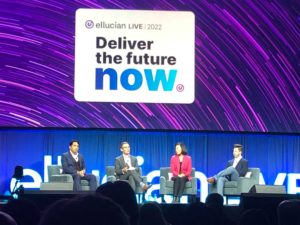Highlights from a panel at Ellucian Live, moderated by Matt Sigelman, President of The Burning Glass Institute and featuring Rishi Rana, Executive Vice President of PeopleAdmin, Dr. Becky Takeda-Tinker, Recovery Officer for the Departments of Labor and Employment and Higher Education (Colorado), and Joel Sackett, Ellucian’s VP of Product Management.
Statistics from across the student lifecycle tell a clear story: students deserve a better journey.

59% of undergraduate students don’t finish their degrees on time, and 43% of undergraduates land in a job that doesn’t require their earned degree. HigherEd has struggled to align with the evolving skills landscape. In many critical fields, the number of graduates is insufficient to keep up with rising demand. Only 18% of credentials earned in Career and Technical Education (CTE) programs are in demand by industry, while many other high-value certifications are undersupplied. Five years after graduating their first class, two-thirds of CTE programs are well below the threshold of financial viability
Equity issues are also a major concern. Only 48% of students of color are satisfied with their college experience, which is 20% below the satisfaction rates for their white peers. First generation students are 3 times more likely than their peers to drop out of college.
Examining data like this from across silos and throughout the student lifecycle can offer vital insights into the next steps for the world of education and student success, from elementary all the way through HigherEd.
What can we do?
Identifying ways to solve problems and remove roadblocks early on is key to increasing equity and building a better student journey. 43% of high school students don’t decide whether or not they’re going to college until they are in 12th grade. Often, prospective first-generation college students are among this 43%, because they don’t have the same access to mentoring resources.
At PowerSchool, we are building dashboarding technology that ensures a holistic view of a student, so teachers, administrators, and mentors can understand where they might need that extra support – for instance, helping first-generation students through the college application process. Our dashboards demonstrate student outcomes and student success related to their college and career readiness, and even life readiness.
High school teachers and administrators spend four years teaching and supporting their students, yet are often left wondering what happened to their students once they left high school. Did they pursue the same programs they were considering as a high school senior, or did they choose a different path? What career did they end up in? For teachers and counselors to understand how successful their teaching and mentorship efforts are, they need more access to long-term student outcome metrics.
Similarly, secondary education institutions need access to metrics about future students to assess whether the programs they’re teaching are relevant. Today, many students who leave high school want to work and study at the same time. What programs can high schools and HigherEd institutions build together to create a successful student journey, connect work and learning, and enable students to seamlessly continue the learning experience from high school all the way through post-secondary education? These are the problems that data insights can help solve.
 One important first step for administrators is early warning interventions. Educational institutions at all levels have so much data in their systems which, if reported at the right time, could help teachers or mentors catch early signs that a student is at risk of dropping out, failing a class, or getting off track. Catching at-risk students early helps ensure that students are successful on their full educational journey. At PowerSchool and PeopleAdmin, we’re dedicated to making this information accessible and increasing student success. Every percentage point shift that we make is a huge achievement.
One important first step for administrators is early warning interventions. Educational institutions at all levels have so much data in their systems which, if reported at the right time, could help teachers or mentors catch early signs that a student is at risk of dropping out, failing a class, or getting off track. Catching at-risk students early helps ensure that students are successful on their full educational journey. At PowerSchool and PeopleAdmin, we’re dedicated to making this information accessible and increasing student success. Every percentage point shift that we make is a huge achievement.